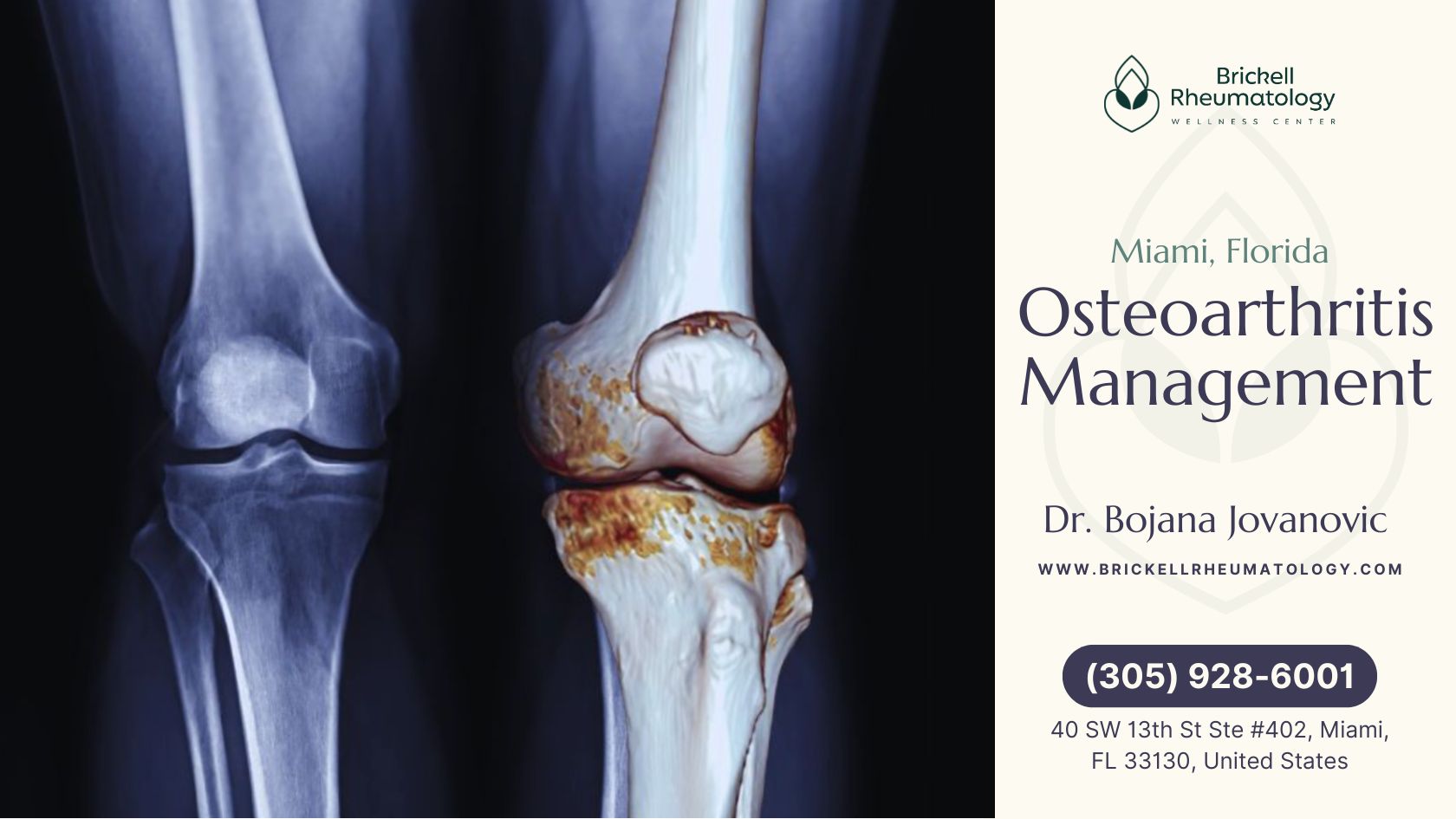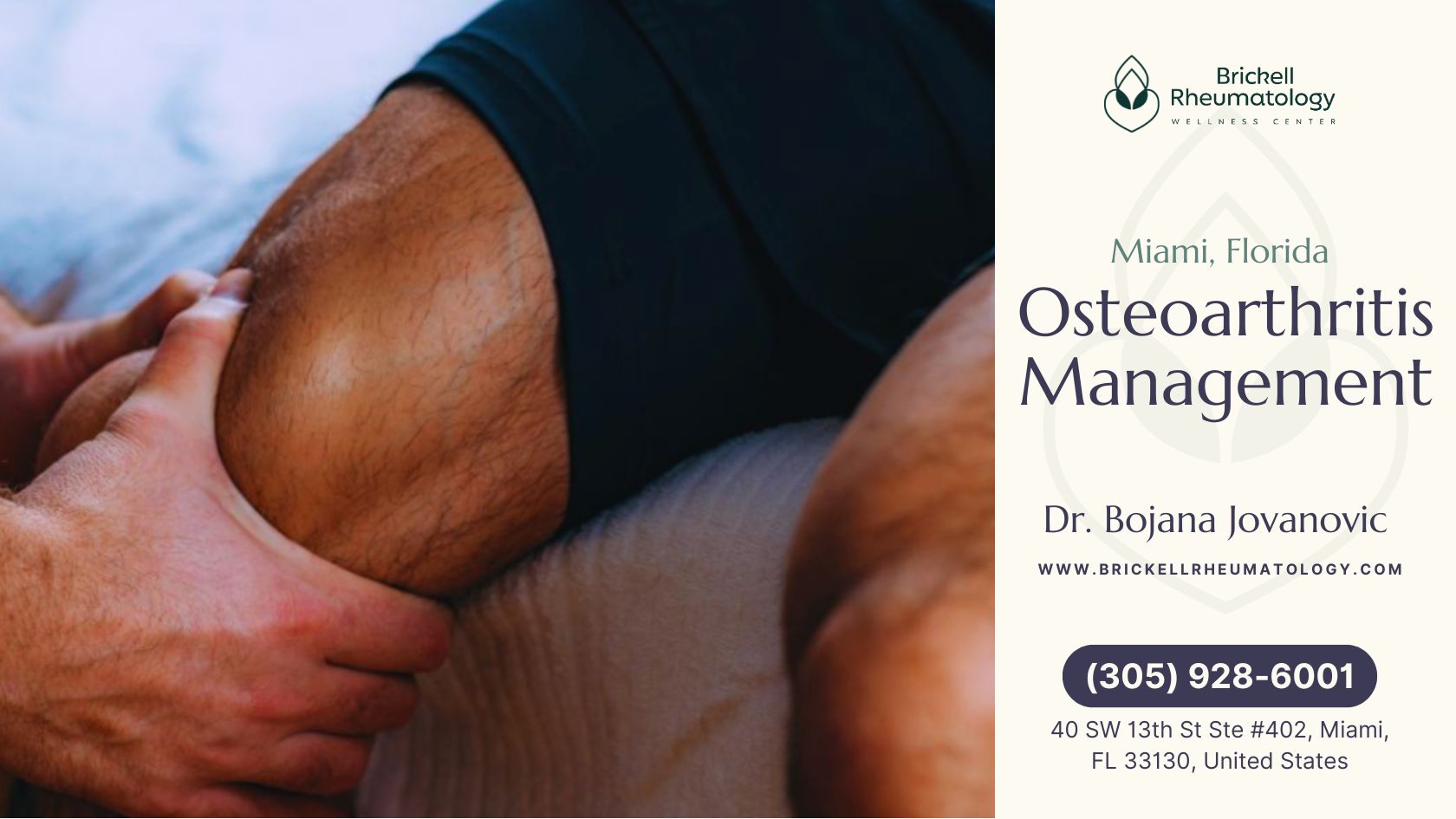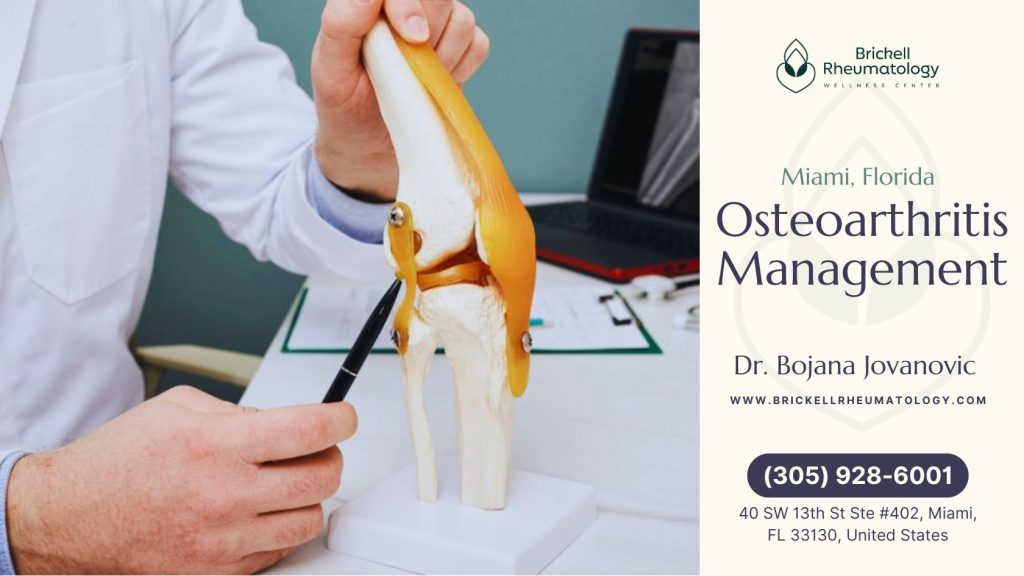Osteoarthritis Management in Miami, FL
by Brickell Rheumatology Wellness Center
Miami, Florida Osteoarthritis Management
Osteoarthritis causes joint stiffness, pain, and reduced mobility, often making everyday activities like walking, climbing stairs, or gripping objects difficult. It happens when the cartilage that protects the bones gradually breaks down, leading to discomfort and swelling. While it most commonly affects the knees, hips, hands, and spine, osteoarthritis can impact any joint.

At Brickell Rheumatology Wellness Center, we take a comprehensive approach to osteoarthritis management in a supportive and compassionate environment. Our program focuses on relieving pain, improving mobility, and enhancing your daily life. Dr. Bojana Jovanovic creates personalized treatment plans that may include physical therapy, lifestyle changes, and advanced therapies tailored to your needs. Take control of your joint health and begin your journey toward lasting relief. Our goal is to help you move more freely and live more comfortably.
Call Brickell Rheumatology Wellness Center at (305) 928-6001 Today!
What Is Osteoarthritis?
Osteoarthritis is a joint condition that causes pain, stiffness, and reduced mobility as the cartilage protecting the joints gradually wears down. It most commonly affects the knees, hips, hands, and spine. Factors such as aging, genetics, past injuries, obesity, repetitive stress, and chronic inflammation contribute to its onset. Early detection and treatment can help preserve joint function and enhance quality of life. Taking action early can manage the condition and prevent further damage.
Treatment Options for Osteoarthritis
Medications
Pain Relievers
Pain relievers, like acetaminophen, effectively manage osteoarthritis discomfort by blocking pain signals in the brain. While they don’t reduce inflammation, they are widely recommended for mild to moderate pain. For more severe cases, stronger prescriptions may be required, but over-the-counter options such as acetaminophen (Tylenol) can still provide relief. Long-term opioid use may carry risks, such as dependence, so it’s important to manage pain under a doctor’s guidance to minimize side effects like gastrointestinal issues or liver damage.
Anti-Inflammatory Drugs
Nonsteroidal anti-inflammatory drugs (NSAIDs) like ibuprofen and naproxen reduce osteoarthritis pain and inflammation by blocking the enzymes that cause swelling. Available over-the-counter or by prescription, NSAIDs help ease discomfort in stiff, swollen joints. Some people prefer topical NSAIDs for more targeted relief with fewer systemic side effects. While effective, long-term use can lead to risks, including kidney problems, stomach ulcers, and heart issues (Department of Health & Human Services, n.d.).
Therapy
Physical Therapy
Alt Text: A physical therapist gently applies pressure to a patient’s knee during manual therapy to improve joint mobility, ease pain, and strengthen nearby muscles.

Physical therapy supports joint health by improving flexibility, reducing stiffness, and strengthening the muscles around affected joints. Therapists develop personalized exercises that enhance mobility and joint function. Stretching boosts the range of motion, while strengthening routines improve joint stability. Low-impact activities like swimming or cycling help ease the stress on the joints. Assistive tools, such as braces or orthotics, may also be incorporated. With consistent sessions, physical therapy empowers individuals to stay active, maintain independence, and manage osteoarthritis more effectively.
Occupational Therapy
Occupational therapy helps osteoarthritis patients adapt their daily activities to reduce joint strain and maintain independence. Therapists provide strategies to improve ergonomics, such as modifying workspaces, using assistive devices, or recommending adaptive tools for household tasks. Techniques like joint protection and energy conservation help prevent excessive stress in affected areas. For example, using larger handles on utensils or wearing supportive braces can ease discomfort. By implementing these adjustments, patients can continue performing essential tasks while minimizing pain and further joint deterioration.
Surgical and Other Procedures
Joint Replacement
When alternative treatments fail, severe osteoarthritis may require arthroplasty or joint replacement surgery. Artificial parts, usually composed of ceramic, plastic, or metal, are used to replace damaged joint surfaces. Hip and knee replacements are the most popular; they greatly lessen pain and restore mobility. Physical therapy is part of the recovery process to restore mobility and strength. Even though surgery is very effective, there are dangers, like infection or implant wear over time. Joint replacement significantly enhances quality of life and restores everyday function for a large number of patients.
Bone Realignment
Osteotomy, or bone realignment surgery, redistributes the weight-bearing load on a joint. It is often recommended for younger patients with knee osteoarthritis who want to delay joint replacement. The procedure relieves pressure on the affected area by redistributing the load. Recovery involves physical therapy and several months of rehabilitation. While not a permanent solution, bone realignment can significantly ease symptoms, improve joint function, and slow the progression of osteoarthritis, allowing patients to stay mobile longer.
Lifestyle and Home Remedies
Exercise
Regular exercise helps manage osteoarthritis by strengthening the muscles around affected joints, improving flexibility, and alleviating stiffness. Low-impact activities like swimming, walking, and cycling are ideal as they minimize joint stress while enhancing mobility. Strength training helps support joints, and stretching increases the range of motion. Exercise also boosts circulation, reducing inflammation and pain. Under the supervision of a physical therapist, a well-rounded regimen can improve the quality of life and overall joint function.
Weight Control
Carrying excess weight speeds up joint wear, causing stiffness and pain. Maintaining a healthy weight reduces strain on weight-bearing joints like the spine, hips, and knees, helping to ease osteoarthritis symptoms. By adopting healthier lifestyle habits, such as regular exercise and a nutrient-rich diet, you can improve your health. Even modest weight loss can boost comfort, enhance mobility, lower joint pressure, and slow the progression of the condition, giving you more control over your well-being.
Heat and Cold Therapy
Applying heat or cold can help relieve osteoarthritis pain and stiffness. Heat therapy, using warm towels, heating pads, or warm baths, relaxes muscles, enhances circulation, and eases stiffness. Ice packs and cold compresses are examples of cold treatment that lower inflammation and dull acute pain. Switching between hot and cold therapies could provide relief by reducing inflammation and alleviating pain. These accessible therapies can be incorporated regularly to alleviate discomfort and support daily function.
Assistive Devices
Assistive devices help reduce joint strain and improve mobility for osteoarthritis patients. Canes, walkers, and braces provide extra support, while ergonomic tools, such as jar openers and thick-handled utensils, make daily tasks easier. Shoe inserts or custom orthotics improve joint alignment and reduce pressure on affected areas. Using assistive devices can enhance independence, minimize pain, and prevent further joint deterioration, allowing individuals to maintain an active lifestyle.
Prevention of Osteoarthritis
Regular Exercise
Regular exercise increases flexibility, maintains healthy cartilage, and strengthens the muscles around joints. Low-impact activities that increase mobility and reduce joint stress include swimming, cycling, and walking. Strength training encourages joint stability, but stretching expands the range of motion. Exercise also improves circulation, which reduces inflammation and stiffness. By protecting joints from harm over time, a well-rounded program lowers the risk of developing osteoarthritis.
Maintain a Healthy Weight
Excess body weight accelerates cartilage degeneration by increasing strain on the knees and hips. Osteoarthritis risk is decreased, and joint tension is lessened by maintaining a healthy weight. Weight management requires both a nutrient-dense diet and regular exercise. By improving long-term joint health, lowering inflammation, and significantly reducing joint strain, even modest weight loss can substantially reduce the risk of osteoarthritis.
Avoid Injury and Repetitive Movements
Protecting joints from injury and overuse helps reduce the risk of osteoarthritis. High-impact activities, improper lifting, and repetitive motions can damage joints over time. To prevent injury, wear supportive footwear during physical activities and use ergonomic tools for repetitive tasks. Practicing proper form, taking breaks, and using protective gear can reduce joint stress. Strengthening muscles and maintaining flexibility helps absorb impact and support joint stability. Preventing injuries keeps joints functioning properly and reduces the likelihood of developing osteoarthritis.
Frequently Asked Questions
Is There a Cure for Osteoarthritis?
There is no cure for osteoarthritis, but treatments can manage symptoms and slow its progression. Maintaining a healthy weight and staying active can reduce joint stress and improve mobility.
What Are the Common Symptoms of Osteoarthritis?
Common symptoms of osteoarthritis include joint pain, stiffness (especially after resting), and a reduced range of motion. Many individuals also experience swelling, tenderness, or a grating sensation when moving the affected joint. Symptoms often worsen over time and may fluctuate in severity. In some cases, bone spurs can develop, causing additional discomfort. While osteoarthritis primarily affects weight-bearing joints like the knees and hips, it can also impact the hands, spine, and other areas, making daily activities more challenging.
What Type of Exercise Is Good for Osteoarthritis?
The type of exercise good for osteoarthritis includes low-impact activities like walking, swimming, and cycling. Without placing undue strain on the joints, these exercises assist in preserving flexibility, developing muscles, and enhancing joint function. Strength training promotes joint stability while range-of-motion activities and stretching can improve mobility. Exercises involving water are especially beneficial since they provide resistance for developing muscles while easing joint discomfort. Frequent moderate exercise can enhance joint health overall, lessen stiffness, and assist in managing symptoms.
What Is the Role of Physical Therapy in Osteoarthritis Management?
Physical therapy plays a crucial role in osteoarthritis management by enhancing joint function, strength, and flexibility while also helping individuals manage pain. A physical therapist creates personalized exercises to boost mobility, reduce stiffness, and strengthen muscles around affected joints. Techniques such as manual therapy, stretching, and low-impact movements alleviate discomfort and help prevent further joint damage. Physical therapy also guides patients in proper movement techniques and lifestyle changes to reduce strain, promote long-term joint health, and improve overall quality of life.
Osteoarthritis Management

At Brickell Rheumatology Wellness Center, we understand that managing osteoarthritis is about more than just relieving pain. It’s about improving your quality of life and helping you move freely again. Dr. Bojana Jovanovic offers a personalized approach that prioritizes long-term health and well-being. If you’re looking for a deeper, more tailored approach to osteoarthritis management, we invite you to schedule a consultation. Investing in your health today can lead to a more active and fulfilling future.
Call Brickell Rheumatology Wellness Center at (305) 928-6001 Today!
Reference:
Department of Health & Human Services. (n.d.). Medications – nonsteroidal anti-inflammatory drugs. Better Health Channel. Retrieved from: https://www.betterhealth.vic.gov.au/health/conditionsandtreatments/medications-non-steroidal-anti-inflammatory-drugs
Brickell Rheumatology Wellness Center
40 SW 13th St Ste #402, Miami, FL 33130, United States
(305) 928-6001
- 40 SW 13th St Ste #402, Miami, FL 33130, United States
- (305) 928-6001
- info@brickellrheumatology.com
- Mon - Fri: 9:00am - 3:00pm
- Sat - Sun: Closed
